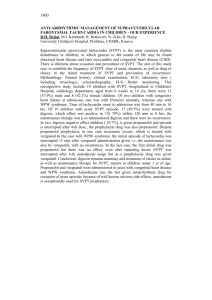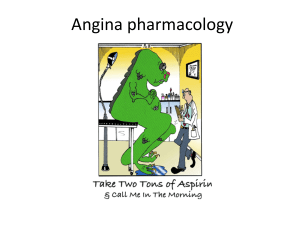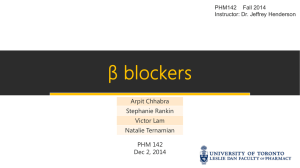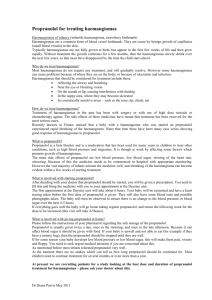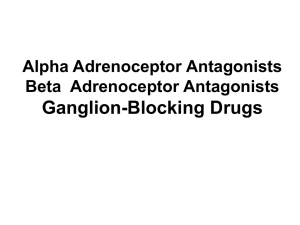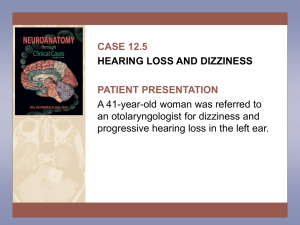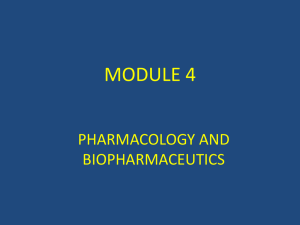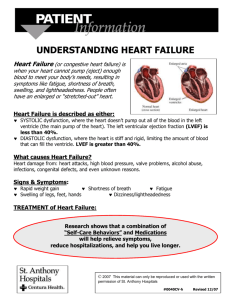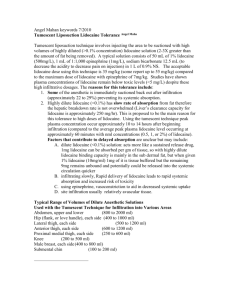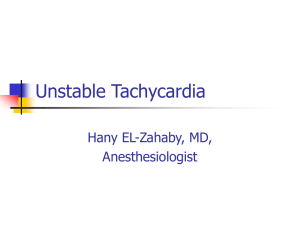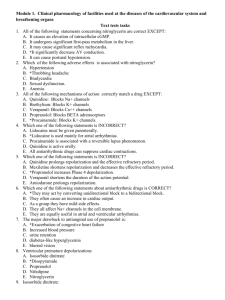All of the following statements concerning nitroglycerin are correct
advertisement
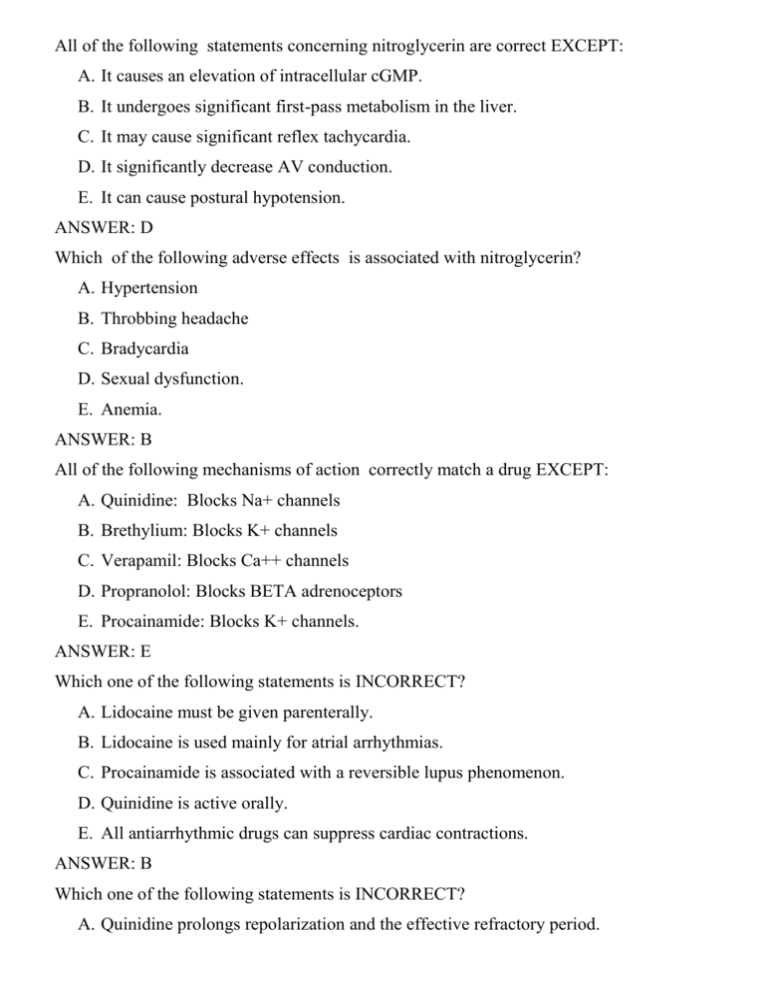
All of the following statements concerning nitroglycerin are correct EXCEPT: A. It causes an elevation of intracellular cGMP. B. It undergoes significant first-pass metabolism in the liver. C. It may cause significant reflex tachycardia. D. It significantly decrease AV conduction. E. It can cause postural hypotension. ANSWER: D Which of the following adverse effects is associated with nitroglycerin? A. Hypertension B. Throbbing headache C. Bradycardia D. Sexual dysfunction. E. Anemia. ANSWER: B All of the following mechanisms of action correctly match a drug EXCEPT: A. Quinidine: Blocks Na+ channels B. Brethylium: Blocks K+ channels C. Verapamil: Blocks Ca++ channels D. Propranolol: Blocks BETA adrenoceptors E. Procainamide: Blocks K+ channels. ANSWER: E Which one of the following statements is INCORRECT? A. Lidocaine must be given parenterally. B. Lidocaine is used mainly for atrial arrhythmias. C. Procainamide is associated with a reversible lupus phenomenon. D. Quinidine is active orally. E. All antiarrhythmic drugs can suppress cardiac contractions. ANSWER: B Which one of the following statements is INCORRECT? A. Quinidine prolongs repolarization and the effective refractory period. B. Mexiletine shortens repolarization and decreases the effective refractory period. C. Propranolol increases Phase 4 depolarization. D. Verapamil shortens the duration of the action potential. E. Amiodarone prolongs repolarization. ANSWER: C Which one of the following statements about antiarrhythmic drugs is CORRECT? A. They may act by converting unidirectional block to a bidirectional block. B. They often cause an increase in cardiac output. C. As a group they have mild side effects. D. They all affect Na+ channels in the cell membrane. E. They are equally useful in atrial and ventricular arrhythmias. ANSWER: A The major drawback to antianginal use of propranolol is: A. Exacerbation of congestive heart failure B. Increased blood pressure C. urine retention D. diabetes-like hyperglycemia E. blurred vision ANSWER: A Ventricular premature depolarizations A. Isosorbide dinitrate B. Disopyramide C. propranolol D. Nifedipine E. Nitroglycerin ANSWER: B Isosorbide dinitrate: A. Antiarrhythmic action is via alpha-adrenergic blockade B. Ventricular premature depolarizations C. Angina pectoris prophylaxis D. Conversion of atrial fibrillation to sinus rhythm E. Treatment of ventricular fibrillation ANSWER: C When quinidine is administered to a patieny with atrial fibrilation A. the ventricular rate may increase dangerously B. arterial hypotension usually results if the drug is administered intravenously C. thrombi attached to fibrillating atria may embolize D. all are correct E. none are correct ANSWER: D Agents which may lower circulating plasma lipids include: A. Clofibrate B. Nicotinic acid C. Cholestyramine D. Dextrothyroxine E. All are correct ANSWER: E Decreases automaticity of ectopic pacemakers A. Quinidine B. Lidocaine C. Both D. Nitroglycerin E. Neither ANSWER: C Increases transmembrane action potential duration: A. Lidocaine B. Quinidine C. Atenolol D. Digoxin E. Esmolol ANSWER: B Extensively metabolized by circulating enzymes: A. Quinidine B. Lidocaine C. Nicotinic acid D. Cholestyramine E. Neither ANSWER: E Which one of the following is the most common side effect of antihyperlipidemic drug therapy ? A. Elevated blood pressure B. Gastrointestinal disturbance C. Neurological problems D. Heart palpitations E. Migraine headaches ANSWER: B Which one of the following hyperlipidemias is characterized by elevated plasma levels of chylomicrons and has no drug therapy available to lower the plasma lipoprotein levels? A. Type I B. Type II C. Type III D. Type IV E. Type V ANSWER: A Which one of the following drugs decreases de novo cholesterol synthesis by inhibiting the enzyme 3-hydroxy-3-methylglutaryl CoA reductase? A. Clofibrate B. Niacin C. Cholestyramine D. Lovastatin E. Gemfibrozil ANSWER: D Binds bile acids in the intestine, thus preventing their return to the liver via the enterohepatic circulation: A. Niacin B. Clofibrate C. Cholestyramine D. Probucol E. Lovastatin ANSWER: B Cause a decrease in plasma triacylglycerol levels by increasing the activity of lipoprotein lipase: A. Lovastatin B. Clofibrate C. Cholestyramine D. Niacin E. Probucol ANSWER: C Cause a decrease in liver triacylglycerol synthesis by limiting available free fatty acids needed as building blocks for this pathway: A. Cholestyramine B. Niacin C. Clofibrate D. Probucol E. Lovastatin ANSWER: B Inhibits 3-hydroxy-3-methylglutaryl CoA reductase, the rate-limiting step in cholesterol synthesis: A. Lovastatin B. Niacin C. Cholestyramine D. Clofibrate E. Probucol ANSWER: A Which one of the following drugs is useful in treating tachycardia? A. Phenoxybenzamine B. Isoproterenol C. Phentolamine D. Propranolol E. Prazosin ANSWER: D Equilibrium between plasma and tissue levels for quinidine is reached: A. in 1 or 2 d B. in approximately 1 wk C. in 1–3 wk D. in just a few minutes E. in 2 h ANSWER: A Equilibrium between plasma and tissue levels for phenytoin is reached: A. in approximately 1 wk B. in 1 or 2 d C. in 1–3 wk D. in just a few minutes E. in 2 h ANSWER: A Equilibrium between plasma and tissue levels for amiodarone is reached: A. in 1–3 wk B. in 1 or 2 d C. in approximately 1 wk D. in just a few minutes E. in 2 h ANSWER: A Equilibrium between plasma and tissue levels for IV lidocaine is reached: A. in just a few minutes B. in 1 or 2 d C. in approximately 1 wk D. in 1–3 wk E. in 2 h ANSWER: A Drowsiness, paresthesias, muscle twitching, convulsions, changes in mental status (eg, confusion), hypersensitivity reactions (eg, urticaria, edema, anaphylaxis) – adverse effects of: A. Lidocaine B. Phenytoin C. Propranolol D. Disopyramide E. Verapamil ANSWER: A Adverse effects of nitrates are: A. hypotension, dizziness, tachycardia B. bradycardia, bronchospasm, heart failure C. peripheral edema, headache, heart failure D. nausea and constipation E. lightheadedness, weakness, peripheral edema ANSWER: A GI problems—nausea, vomiting, flatulence, constipation or diarrhea, abdominal discomfort are the most common adverse effects of: A. dyslipidemic drugs B. calcium channel blockers C. beta-adrenergic blocking agents D. nitrates E. all of the above ANSWER: A Which of the following adverse effects is associated with nitroglycerin? A. Bronchospasm B. Throbbing headache C. Bradycardia D. Sexual dysfunction. E. Anemia. ANSWER: B Nausea, vomiting, flatulence, constipation or diarrhea, abdominal discomfort are the most common adverse effects of: A. dyslipidemic drugs B. calcium channel blockers C. beta-adrenergic blocking agents D. nitrates ANSWER: A All of the following statements concerning nitroglycerin are correct EXCEPT: A. It causes an elevation of intracellular cGMP. B. It undergoes significant first-pass metabolism in the liver. C. It may cause significant reflex tachycardia. D. It can not cause throbbing headache. E. It can cause postural hypotension. ANSWER: D Which of the following adverse effects is associated with nitroglycerin? A. Hypertension B. Increasing of intracranial pressure C. Bradycardia D. Sexual dysfunction. E. Anemia. ANSWER: B Which one of the following statements is INCORRECT? A. Atenolol increases Phase 4 depolarization. B. Mexiletine shortens repolarization and decreases the effective refractory period. C. Quinidine prolongs repolarization and the effective refractory period. D. Verapamil shortens the duration of the action potential. E. Amiodarone prolongs repolarization. ANSWER: A The major drawback to antianginal use of atenolol is: A. Diabetes-like hyperglycemia B. Increased blood pressure C. Urine retention D. Exacerbation of congestive heart failure E. Blurred vision ANSWER: D Nitroderm is used: A. Antiarrhythmic action is via (-adrenergic blockade B. Ventricular premature depolarizations C. Angina pectoris prophylaxis D. Conversion of atrial fibrillation to sinus rhythm E. Treatment of ventricular fibrillation ANSWER: C When quinidine is administered to a patient with atrial fibrilation A. the ventricular rate may increase dangerously B. arterial hypotension usually results if the drug is administered intravenously C. thrombi attached to fibrillating atria may embolize D. all are correct E. none are correct ANSWER: D Agents which may lower circulating plasma lipids include: A. Atorvastatin B. Nicotinic acid C. Cholestyramine D. Dextrothyroxine E. All are correct ANSWER: E Which one of the following is a specific alpha-adrenergic antagonist: A. Atenolol B. Timolol C. Labetalol D. Terazosin E. Sotalol ANSWER: D Inhibits 3-hydroxy-3-methylglutaryl CoA reductase, the rate-limiting step in cholesterol synthesis: A. Pravastatin B. Niacin C. Cholestyramine D. Clofibrate E. Probucol ANSWER: A Adverse effects of organic nitrates are: A. nausea and constipation B. bradycardia, bronchospasm, heart failure C. peripheral edema, headache, heart failure D. throbbing headache, dizziness, tachycardia E. lightheadedness, weakness, peripheral edema ANSWER: D What diuretic is used for the removal of hypertensive crisis? A. Dichlothiazide B. Furosemide C. Spironolactonum D. Mannitum E. Triamteren ANSWER: B Indicate the antiarrytmic drug from of adrenoblockers group A. Nitroglycerin B. Amiodaron C. Metoprolol D. Verapamil E. Asparcam ANSWER: C The drug related to the group of calcium antagonists A. Apressinum B. Prazosinum C. Nifedipine D. Reserpine E. Papaverini hydrochloridum ANSWER: C Mechanism of action of cardiac glycosides A. Block the activity of COX2 B. Cause the dilatation of coronary vessels C. Block the beta-adrenoreceptors D. Block the calcium channels E. Block the activity of adenosine-tryphosphatase (ATP-ase) ANSWER: E A drug that can selectively supress automaticity in Purkinje fibers compared to the sinus node: A. verapamil B. atenolol C. propranolol D. diltiazem E. lidocaine ANSWER: E A drug, or class of drugs, that has been documented to reduce mortality following a myocardial infarction: A. Class Ia antiarrhythmics B. Class Ic antiarrhythmics C. Class II antiarrhythmics D. digoxin E. Class III antiarrhythmics ANSWER: C GI upset, tinnitus and cinchonism are common side effects of: A. lidocaine B. digoxin C. propranolol D. quinidine E. amiodarone ANSWER: D An antiarrhythmic drug with the most "non-selective" mechanism of action: A. lidocaine B. Quinidine C. Propranolol D. Sotalol E. amiodarone ANSWER: D A primary mechanism by which Class I antiarrhythmic drugs produce their therapeutic effect in patients with ventricular arrhythmias: A. Block L-type Ca channels B. Block beta-adrenergic receptors C. Increase the Effective Refractory Period D. Increase vagal tone to the AV node E. Increase the dispersion of refractoriness ANSWER: C Primary indications for treatment of cardiac arrhythmias include all of the following EXCEPT: A. Arrhythmias that reduce cardiac output B. Arrhythmias that are prone to degenerate into more serious arrhythmias C. Arrhythmias that cause vascular stasis D. Arrhythmias that increase the risk of stroke E. Monomorphic premature ventricular beats ANSWER: A A side effect of furosemide that can increase the automaticity of ectopic cardiac pacemakers: A. hypercalcemia B. hyperkalemia C. hypokalemia D. hyponatremia E. hypothyroidism ANSWER: C In the treatment of exertional angina: A. nitroglycerin reduces O2 demand by decreasing preload B. nitroglycerin increases O2 supply by dilating atherosclerotic vessels C. attacks frequently occur during sleep D. nitroglycerin increases cardiac myocyte cAMP levels E. beta blocking agents have no beneficial action ANSWER: A Diltiazem: A. decreases calcium entry through L type channels B. increases total peripheral resistance C. increases cardiac output D. increases heart rate E. increases gastrointestinal motility ANSWER: A A drug effect that is produced by therapeutic doses of both propranolol and amiodarone is blockade of: A. cardiac Na channels B. cardiac K channels C. beta-adrenoceptors D. alpha-adrenoceptors E. L-type Ca channels ANSWER: C The most common cellular mechanism responsible for production of cardiac arrhythmias in patients with ischemic heart disease: A. Hypokalemia B. depressed automaticity C. sick sinus syndrome D. reentrant excitation E. hormonal imbalance ANSWER: A In a patient with a high risk for coronary artery disease (LDL cholesterol 200 mg/dL, normal tryglycerides), the best lipid lowering drug would be: A. nicotinic acid B. gemfibrozil C. atorvastatin D. colestipol E. cholestyramine ANSWER: E Indicate the antiarrythmic drug which exerts membrane-stabilizing action. A. Atenolol B. Quinidine sulfate C. Nitroglycerin D. Digoxin E. Isadrinum ANSWER: B Nitrates relieve angina pain by reducing preload, which is: A. Oxygen demand of the heart B. Pressure within the heart C. Blood volume within the heart D. Pressure against which the heart must pump E. Contractility of the heart muscle ANSWER: A Indicate the side effect of nitroglycerine A. Itching of skin B. Bradicardia C. Headache D. Rise of arterial pressure E. Intestine atony ANSWER: C Indicate the Verapamil possible side effect, as antiarrhythmic drug A. Tachycardia B. Bronchospasm C. Stenocardia D. Mouth dryness E. Decrease of artery pressure (hypotension) ANSWER: E Nifedipine and verapamil both A. cause coronary vasodilation B. depress atrioventricular nodal conduction C. cause reflex tachycardia D. stimulate calcium entry into cells ANSWER: A Which of the following agents is selective for (beta1-adrenergic receptor? A. Metaproterenol B. Propranolol C. Metoprolol D. Terbutalin E. Timolol ANSWER: C Selective blockade of beta1-adrenergic receptors: A. Labetalol B. Prazosin C. Timolol D. Atenolol E. Sotalol ANSWER: D is a specific alpha-adrenergic antagonist: A. Prazosin B. Timolol C. Labetalol D. Atenolol E. Sotalol ANSWER: A Labetalol is: A. a selective alpha-adrenergic antagonistas well as a nonspecific beta-adrenergic antagonist B. is a specific alpha-adrenergic antagonist C. is a nonspecific beta-adrenergic antagonist D. is a selective beta1-adrenergic blocker E. Neither ANSWER: A Which of the following agents is (are) pure beta1-adrenergic agonists? A. Albuterol B. Propranolol C. Metoprolol D. Isoproterenol E. Timolol ANSWER: C Weakness or dizziness, especially with activity or exercise – adverse effects of: A. Propranolol B. Phenytoin C. Lidocaine D. Disopyramide E. Verapamil ANSWER: A Adverse effects of beta-adrenergic blocking agents are: A. bradycardia, bronchospasm, heart failure B. hypotension, dizziness, lightheadedness C. headache, heart failure, pulmonary edema, D. nausea and constipation E. hypotension, dizziness, tachycardia ANSWER: A Adverse effects of calcium channel blockers are: A. dizziness, lightheadedness, peripheral edema, constipation B. bradycardia, bronchospasm, heart failure C. hypotension, tachycardia, headache D. palpitations and headache E. hypotension, dizziness ANSWER: A The mechanism by which digoxin causes a positive inotropic effect on heart tissue is by: A. increasing ATP hydrolysis B. stimulating the Na/K pump C. increasing intracellular Na and Ca D. sensitizing the heart to catecholamines E. inhibiting the Na/H exchanger ANSWER: C Calcium channel blockers with prolong action: A. Nifedipine B. Verapamil C. Diltiazem D. Amlodipine E. Nebivolol ANSWER: D All of the following mechanisms of action correctly match a drug EXCEPT: A. Quinidine: Blocks Na+ channels B. Brethylium: Blocks K+ channels C. Verapamil: Blocks Ca++ channels D. Propranolol: Blocks beta adrenoceptors E. Sotalol: Blocks K+ channels. ANSWER: E The major drawback to antianginal use of metoprolol is: A. Exacerbation of congestive heart failure B. Increased blood presure C. urine retention D. blurred vision E. diabetes-like hyperglycemia ANSWER: A Nifedipine and verapamil both A. cause reflex tachycardia B. depress atrioventricular nodal conduction C. cause coronary vasodilation D. stimulate calcium entry into cells ANSWER: C Which of the following agents is selective for beta1-adrenergic receptor? A. Metaproterenol B. Propranolol C. Nebivolol D. Terbutalin E. Esmolol ANSWER: C Selective blockade of beta1-adrenergic receptors: A. Labetalol B. Prazosin C. Timolol D. Atenolol E. Sotalol ANSWER: D Is a specific alpha-adrenergic antagonist: A. Prazosin B. Timolol C. Labetalol D. Atenolol E. Sotalol ANSWER: A Labetalol is A. is a specific alpha-adrenergic antagonist B. a selective alpha-adrenergic antagonistas well as a nonspecific beta-adrenergic antagonist C. is a nonspecific beta-adrenergic antagonist D. is a selective beta1-adrenergic blocker E. Neither ANSWER: B Which of the following agents is (are) pure beta1-adrenergic agonists? A. Albuterol B. Propranolol C. Bisoprolol D. Isoproterenol E. Timolol ANSWER: C Weakness or dizziness, especially with activity or exercise – adverse effects of: A. Doxasozin B. Propranolol C. Lidocaine D. Novocainamid E. Verapamil ANSWER: B Adverse effects of beta-blockers are: A. hypotension, dizziness, tachycardia B. hypotension, dizziness, lightheadedness C. headache, heart failure, pulmonary edema, D. nausea and constipation E. bradycardia, bronchospasm, heart failure ANSWER: E Adverse effects of calcium channel blockers are: A. hypotension, dizziness B. bradycardia, bronchospasm, heart failure C. hypotension, tachycardia, headache D. palpitations and headache E. dizziness, lightheadedness, peripheral edema, constipation ANSWER: E Call calcium channel blockers with prolong action: A. Felodipine B. Verapamil C. Diltiazem D. Nifedipine E. Nebivolol ANSWER: A Amlodipine and verapamil both A. cause coronary vasodilation B. depress atrioventricular nodal conduction C. cause reflex tachycardia D. stimulate calcium entry into cells ANSWER: A Which of the following agents is selective for beta1-adrenergic receptor? A. Salmeterol B. Propranolol C. Bisoprolol D. Terbutalin E. Timolol ANSWER: C Selective blockade of beta1-adrenergic receptors: A. Amiodaron B. Lisinopril C. Timolol D. Atenolol E. Sotalol ANSWER: D Labetalol is A. Neither B. is a specific alpha-adrenergic antagonist C. is a nonspecific beta-adrenergic antagonist D. is a selective beta1-adrenergic blocker E. a selective alpha-adrenergic antagonists well as a nonspecific beta-adrenergic antagonist ANSWER: E Which of the following agents is (are) pure beta1-adrenergic agonists? A. Bisoprolol B. Sotalol C. Albuterol D. Isoproterenol E. Timolol ANSWER: A Which one of the following drugs is useful in treating tachycardia? A. Bisoprolol B. Phentolamine C. Isoproterenol D. Phenoxybenzamine E. Prazosin ANSWER: A Weakness or dizziness, especially with activity or exercise – adverse effects of: A. Propranolol B. Phenytoin C. Lidocaine D. Disopyramide E. Diltiazem ANSWER: A Adverse effects of beta-adrenoblockers agents are: A. hypotension, dizziness, tachycardia B. hypotension, dizziness, lightheadedness C. headache, heart failure, pulmonary edema, D. nausea and constipation E. bradycardia, bronchospasm, heart failure ANSWER: E Adverse effects of nifedipine are: A. bradycardia, bronchospasm, heart failure B. dizziness, lightheadedness, peripheral edema, constipation C. hypotension, tachycardia, headache D. palpitations and headache E. hypotension, dizziness ANSWER: B Call calcium channel blockers with prolong action: A. Isradipine B. Nifedipine C. Diltiazem D. Verapamil E. Nebivolol ANSWER: A Weight gain & edema occur in patients with congestive heart failure in response to: A. increased diuresis B. increased aldosterone levels C. decreased renin levels decreased total peripheral resistance D. decreased venous capacitance ANSWER: B A drug that is NOT known to increase the effect or toxicity of digoxin when given concominantly: A. furosemide B. verapamil C. amiodarone D. propranolol E. quinidine ANSWER: D Automaticity in Purkinje fibers can be most enhanced by A. hypercalcemia B. vagal stimulation C. hyponatremia D. catecholamines E. lidocaine ANSWER: D A drug used in the treatment of systolic congestive heart failure that shifts the Frank Starling curve upwards and to the left, and produces its effects by inhibiting the cardiac Na/K pump: A. Furosemide B. Nifedipine C. captopril D. clonidine E. digoxin ANSWER: E In the treatment of congestive heart failure, choose a drug that would reduce dyspnea and pulmonary edema by decreasing the left ventricular preload: A. Hydralazine B. propranolol C. isosorbide dinitrate D. Dobutamine E. digoxin ANSWER: C Sodium nitroprusside: A. is used to lower blood pressure in a hypertensive emergency B. increases smooth muscle cAMP levels C. is given orally D. has a slow onset and long duration of action E. inhibits nitric oxide formation ANSWER: A
